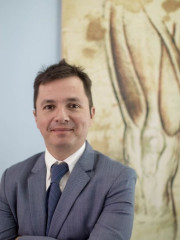
A. Jaramillo (Medellín, Colombia, CO)
Fundacion Clinica del Norte Orthopedic and traumatology servicePresenter Of 1 Presentation
P058 - Autologous Matrix-induced Chondrogenesis (AMIC) in the Treatment of Grade IV Chondral Injuries of the Knee
Abstract
Purpose
To evaluate the clinical outcomes of patients treated using AMIC with a hyaluronic acid scaffold in grade IV osteochondral lesions in the knee
Methods and Materials
Retrospective and multicenter study. To determine the clinical outcome of the patients the follow-up was done with the subjective International Knee Documentation Committee (IKDC) score, before the procedure, and with two subsequent evaluations. The present study was approved by the ethics committee of the participating health institutions and was conducted according to the principles expressed in the Declaration of Helsinki. For data analysis, GraphPad Prism V.7.0 software was used.
Results
Were followed 60 patients, for an average time of 24 months and with a mean age of 45 ± 12 years. Most patients were women. The mean size of the lesion was 3 cm2 and the injuries located in the patella and trochlear groove were the most frequent. The patients younger than 45 years presented better clinical outcomes than older ones. Similarly men presented better clinical outcomes than women and a negative correlation was found between the IKDC score and the age. There was a statistically significant improvement in all categories of the IKDC (symptoms, sports activities, function, and activity of daily living) compared between pre-surgery and last results. Besides, satisfactory results were achieved in patients with different clinical characteristics, such as the size of the lesion and its location, presence of injuries in multiple compartments of the knee, and even when the procedure was performed at the same time as the treatment of associated conditions. Likewise, all patients presented a high level of satisfaction with the procedure. Finally, no patient required additional surgeries, and no complications were reported during the follow-up period.
Conclusion
The repair of full-thickness chondral lesions of the knee using AMIC with hyaluronic acid scaffold provides satisfactory clinical results in the short- and medium-term follow-up.
Presenter Of 1 Presentation
P058 - Autologous Matrix-induced Chondrogenesis (AMIC) in the Treatment of Grade IV Chondral Injuries of the Knee
Abstract
Purpose
To evaluate the clinical outcomes of patients treated using AMIC with a hyaluronic acid scaffold in grade IV osteochondral lesions in the knee
Methods and Materials
Retrospective and multicenter study. To determine the clinical outcome of the patients the follow-up was done with the subjective International Knee Documentation Committee (IKDC) score, before the procedure, and with two subsequent evaluations. The present study was approved by the ethics committee of the participating health institutions and was conducted according to the principles expressed in the Declaration of Helsinki. For data analysis, GraphPad Prism V.7.0 software was used.
Results
Were followed 60 patients, for an average time of 24 months and with a mean age of 45 ± 12 years. Most patients were women. The mean size of the lesion was 3 cm2 and the injuries located in the patella and trochlear groove were the most frequent. The patients younger than 45 years presented better clinical outcomes than older ones. Similarly men presented better clinical outcomes than women and a negative correlation was found between the IKDC score and the age. There was a statistically significant improvement in all categories of the IKDC (symptoms, sports activities, function, and activity of daily living) compared between pre-surgery and last results. Besides, satisfactory results were achieved in patients with different clinical characteristics, such as the size of the lesion and its location, presence of injuries in multiple compartments of the knee, and even when the procedure was performed at the same time as the treatment of associated conditions. Likewise, all patients presented a high level of satisfaction with the procedure. Finally, no patient required additional surgeries, and no complications were reported during the follow-up period.
Conclusion
The repair of full-thickness chondral lesions of the knee using AMIC with hyaluronic acid scaffold provides satisfactory clinical results in the short- and medium-term follow-up.



